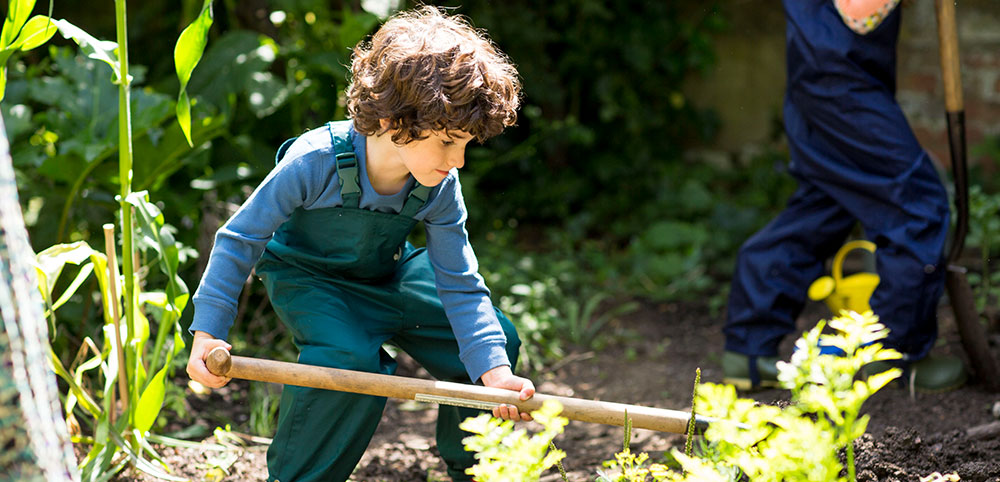
5 Gardening Activities For Children
This week marks National Children’s Gardening Week (24th May – 1st June). It’s a great opportunity to encourage children to grow their own plants, while improving their concentration, creativity, knowledge and connecting with nature.
We have put together five brilliant gardening activities to keep your little gardeners busy outdoors.

Kids love being outdoors and while their curiosity can fuel days’ worth of fun, introducing some simple gardening activities in a child friendly garden will surely keep them entertained. Not only will spending time in the garden and getting some fresh air benefit your little ones both mentally and physically, but it's also a great opportunity for them to learn about plants and nature.
So, if you’re looking to keep your children busy while teaching them something new, get them started with our top five gardening activities.
1) Make a mini vegetable garden
It can be difficult trying to get your little ones to eat their vegetables, but if they’ve grown their own, they’re bound to want to try the fruits of their labour. So, why not set up a mini vegetable patch for them to tend to? First, you’ll need to designate a certain area of soil for your kids to use as their vegetable garden. It’ll also be a good idea to get them involved with the seed selection, so they can have a say in what you’ll grow together — it might even inspire them to try new veggies. Although all vegetables have unique requirements, almost all varieties will need the following basics in order to flourish:
- A well-drained patch of soil which is rich in organic matter like compost (you could use soil improvers if necessary)
- A supply of sunlight
- Regular watering

So, be sure to prioritise these when picking a spot for your child’s vegetable patch. Easy-to-grow vegetables include beets, carrots and tomatoes. You might even want to add some flowers around the borders of your vegetable garden to appeal to your child’s other senses: mint plants will give them something fresh to smell, while lambswool plants are soft to the touch.
2) Create a bird feeder
Kids love animals, and will appreciate learning more about the different types that visit our gardens. Help your kids to welcome various forms of wildlife into your garden by creating homemade feeders: this can include making a homemade bird feeder — we love this easy, kid-friendly apple bird feeder.
 Photo by Karen Uppal on Unsplash
Photo by Karen Uppal on Unsplash
3) Create a fairy garden
Fairy gardens are a great way to pique your kid’s creative side, and it can be a great addition to your garden. It’s incredibly simple to make one and can be completely tailored to your child’s preferences, and as these fairy gardens use typical household items, you can make one anytime. To create your fairy garden, you’ll need:
- Plenty of soil
- A small container or box to put the soil in
- Small plants and flowers to put in the garden
- Decorations for the fairy garden (sprinklings of fairy glitter and figurines will go down well)
- Water
- A big spoon or trowel
- Old newspaper
Once you’ve set up the items needed, get your child to place the box or container onto the newspaper and spoon the soil into it. You can now let them get inventive by adding plants and flowers of their choice to the container, being sure to monitor the watering of these. Let them finish off their fairy garden with figurines and other decorations to make a truly magical space to admire. And, be sure to let them know they can update it as often as they want if they see it losing their sparkle! If fairies aren’t your child’s thing, you could even encourage them to use their imagination and create a mini garden for their favourite superhero or cartoon character.
4) Grow a magic beanstalk
Give your kids something to get excited about by encouraging them to grow their own beanstalk. To get started, you’ll need:
- A mason jar
- Cotton balls
- A dry broad bean or runner bean
- Water
While it’s not a difficult activity, make sure you supervise your child during this, particularly as it’s important to get the water levels right. To plant the beanstalk, help your child to follow this method:
- Wet a few cotton balls and place them in the jar — but be sure not to saturate them.
- Wedge the dry bean between the cotton balls (up against the glass so the growth can be monitored).
- Place the mason jar on a windowsill where it’ll get plenty of sunlight.
- Add drops of water to the cotton balls as needed.
Originally growing the beanstalk indoors will be a great way to ensure your child can make observations about its growth from the initial stages. However, once it has started to outgrow the jar, heading to the garden together to plant it into a patch of well-drained soil or potting it in a larger pot will make the activity both fun and educational for them.
 Photo credit: Love Your Landscape
Photo credit: Love Your Landscape
5) Make seed balls
Seed balls are a great way of letting your kids have fun and get messy, and in time you’ll get to see plenty of new flowers and plants sprouting in your garden, too. Plus, it’ll really give your children the opportunity to get stuck into nature. To make these, you’ll need:
- Clay
- Compost or potting soil
- Water
- Parchment paper
- Flower seeds of your choice
Once you’ve gathered these materials, you’ll want to head to the garden with your kids as this can get messy! To make your balls, you’ll need to:
- Combine the clay and compost, adding a small bit of water if your mixture is dry (it should be moist but not saturated).
- Add the seeds to the clay and compost mixture and mix together with your hands.
- Shape the seed, clay and compost mix into small balls.
- Leave them on a parchment-lined baking tray in the sun to dry.
- Send your kids to the garden to toss them onto the soil or a flower bed and watch the seed bombs sprout into stunning flowers and plants

For a fun twist you could even get your kids to make them into their favourite shapes, like hearts and flowers. Having a mixture of different plants and flowers around your garden will be a great way to ensure it’s looking bright and beautiful even when the weather isn’t! Whether you want to keep your children occupied, or you want an activity to bond over, these garden activities are a great way of doing both.






















